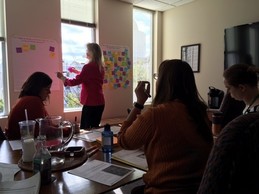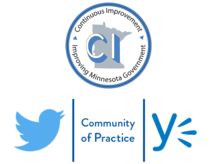|
October 2016
From Our Office
The Times They Are A-Changin'
With fall fading and another winter season fast
approaching, our thoughts turn to how we are changing our work here at the Department of Administration’s MN Office of Continuous
Improvement. We’re in the “change business” and need to work extra hard to be sure
our support of the state’s continuous improvement (CI) culture, capacity, and
results stay current, relevant, and useful!
Over the past nine years, our office has emphasized two things: training
and facilitating LEAN Kaizen events. Starting a year ago, we shifted our focus to
train on foundational continuous improvement principles, changed our projects
from “CI” to “problem-solving” where we manage the full cycle from scope
through implementation, and targeted new managers/supervisors with a unique
“How to build a culture of CI” course. This is working well, and has re-energized some state agencies that had
all but abandoned doing any CI work.
 As we move into calendar year 2017 and prepare for a new biennial budget, we’re making some changes to our approach to solving problems that change lives. For this month, I’ll introduce you to how we’re using Human-centered Design. Per Wikipedia, “Human-centered design (HCD) is a design and management framework that develops solutions to problems by involving the human perspective in all steps of the problem-solving process.”
To help train up the team, I signed us all (and Emily Paoli Johnson from Minnesota Management & Budget’s Workforce Planning team) to do a ‘design challenge’. The smart people at Acumen and IDEO partnered to provide a great seven-week immersion called Design Kit:The Course for Human-centered Design. We’re almost done and have learned a lot about being more human in our problem solving!
Here are a few ways we’re adding human-centered design to how we solve problems that change lives:
- Using intentional ‘get to know you’ tools during project team kickoffs so project team members know each other better.
- Being mindful of empathy for customers, project teams, and leaders.
- Starting each project with a ‘beginner’s mind’ to ensure we limit any biases.
- Interviewing and observing customers of the process, while they use the process.
- Discussing and deciding whether to try to improve the existing process (traditional approach), or start with an entirely new approach (design thinking).
- Designing a solution for a specific customer versus “customers”.
- Utilizing the customer journey/experience map tool.
We’ll continue to change our practices to best serve Minnesotans in making government services as efficient and effective as possible. After all, as a Hopi Elder once said, “we are the ones we’ve been waiting for.” Truly The times they are a-changin’.
Joe Raasch, Director of Continuous Improvement, Department of Administration, Minnesota Office of Continuous Improvement
|
Continuous Improvement Right Outside our Window!
 Construction for the Minnesota State Capitol Restoration Project began in fall 2013 addressing interior, and exterior features in need of improvement. Our offices are located in the Administration Building located behind the Capitol. We have a direct view of the Capitol restoration work, and can witness exterior changes being done every day. With this view we have gotten to observe one tool that we have come to fondly name, “Big Crane”. Big Crane is exactly what you would imagine it to be; it’s a (big) crane that is moving loads of equipment and material around all different parts of the construction site. From moving dumpsters, scaffolding, and chunks of marble; we have get to see how progress is happening around us all the time.
Our team has become a huge advocate for Big Crane just from watching the construction out our conference room window. Before meetings questions such as, “what is Big Crane going to do today?!” pop-up, and when we see big crane moving we literally cheer it on! I understand this sounds a little crazy, but in reality we have become champions for the restoration project! We get to see incremental changes, and when something looks different or closer to completion, we acknowledge the difference together.
I never thought I would become inspired or attached to a piece of construction equipment, but I know I am excited about progress and seeing the end result when the Capitol reopens in January. To me, this is continuous improvement. We are celebrating improvements, and are curious to see what changes will occur in the future.
Can you think of a “big crane” in your work or life right now?
Geneva Martin, Continuous Improvement Coordinator, Department of Administration, Minnesota Office of Continuous Improvement
|
Governor’s Better
Government Awards
This year, we’re
combining the Governor’s Continuous Improvement and Better Government Awards
into one set of awards and a single nomination process.
The 2016 Governor’s Better Government
Awards recognize individual and organizational achievements within Minnesota
state government that provide great customer service, make the state a great
place to work, and have results that are worth sharing enterprise wide.
All Minnesota state agencies and boards are invited to participate!
- The nomination period for the 2016 Awards runs from October 24
– November 18.
- Award categories: Great
Customer Service, Great Place to Work, and Great Results.
To
submit a nomination and for detailed evaluation criteria regarding the 2016
Awards visit the Department of Administration’s Minnesota Office of Continuous
Improvement Governor’s
Better Government Awards page.
Don't Miss...
Sign up and learn time-tested CI methodologies and tools that will help you to solve problems that improve work processes and service quality for Minnesotans!
 Our training courses are designed to provide you with the skills you need and can easily put into action:
- The Introduction to CI training will show you the basics of CI principles. The hands-on simulation activity will help you recognize that no process is perfect and most of them can be improved.
- The Problem Solving course will help you recognize the root cause behind some of the work challenges we face and offers useful strategies for identifying solutions. Much of our work requires us to show results.
- The Process Improvement Measurement course helps you select measure that matter and how to use data to guide and sustain the improvements you make.
With all of these courses you can take the knowledge and skills you learn back to your workplace to implement changes. These efforts have real results, saving resources and staff time, while improving the quality of State services.
In the next month we are offering a Process Improvement Measurement training on Wednesday, November 2 and an Introduction to Continuous Improvement training on Thursday, November 10. For more information and to register for these or other upcoming trainings visit our registration page!
|
CI News
Things We Found Interesting
Other News and Notes
We Want to Connect with YOU!
|
|
 |
|